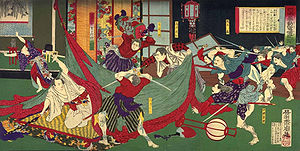Shinpūren rebellion
| Shinpūren Rebellion | |||||||
|---|---|---|---|---|---|---|---|
| Part of Shizoku rebellions of the Meiji period | |||||||
 Shinpūren rebellion. Attack on Major General Taneda Masaaki (種田政明). | |||||||
| |||||||
| Belligerents | |||||||
| Imperial Japanese Army | shizoku rebels of former Kumamoto Domain | ||||||
| Commanders and leaders | |||||||
| Kodama Gentarō | Otaguro Tomoo | ||||||
| Strength | |||||||
| Unknown | 174 | ||||||
| Casualties and losses | |||||||
| 60 dead, 200+ injured | 124+ seppuku, 50 injured | ||||||
The 1876 Shinpūren Rebellion (神風連の乱, Shinpūren no ran / Jinpūren no ran) was one of a number of ex-samurai uprisings which took place in the early Meiji period against the new Meiji government of Japan.[1] The rebellion began in Kumamoto on 24 October 1876.
Background
Following the 1868 Meiji Restoration, many members of the former samurai class were disgruntled with the direction the nation had taken. The abolition of their former privileged social status under the feudal order had also eliminated their income, and the establishment of universal military conscription had replaced much of their former role in the society. The very rapid modernization (Westernization) of the country was resulting in massive changes to Japanese culture, dress and society, and appeared to many samurai to be a betrayal of the joi ("Expel the Barbarian") portion of the Sonnō jōi justification used to overthrow the former Tokugawa shogunate. The Shinpūren was an extremist and xenophobic political society of ex-samurai from Kumamoto Prefecture led by Otaguro Tomoo (1835–1876), which grew out of the teachings of Hayashi Oēn.[2][3] The members were not satisfied with halting the westernization process—they wanted to turn the clock back and eradicate every trace of it, including the wearing of western clothes, use of the Western calendar, and even the use of Western weapons. Members carried salt with them at all times for use in ritual purification of polluting foreign influences, such as electricity, railroads, and even Buddhist priests. They were incensed by government decrees permitting foreigners to purchase land in Japan, to allow missionaries to spread the Christian religion, and to forbid the carrying of swords. A rumor that Emperor Meiji was planning a trip overseas was the final straw.
The revolt

Otaguro was also a Shinto priest, and after several attempts at divination, was given what he considered to be divine authorization to lead an uprising. As the Meiji government had called upon the Imperial Japanese Army garrison at Kumamoto to suppress the Saga Rebellion, Kumamoto itself was only lightly defended. On October 24, after sending messages to like-minded groups in other domains, Otaguro led his 200 men in revolt. He divided his force into squads. One squad launched a surprise night attack on the barracks of the Kumamoto garrison, giving no quarter and showing no mercy even to the wounded or unarmed, spurred on by their hatred of the conscript army, many of whose members were from peasant backgrounds. Some 300 men of the garrison were slaughtered or wounded. A second squad smashed the telegraph office, although this in effect cut the rebels off from their would-be allies. A third squad attacked the offices and residences of Prefectural officials, killing the governor, commander of the Kumamoto garrison and his Chief of Staff.

However, once the remaining garrison officers overcame their surprise at the attack, superior numbers, and especially superior firepower of the defender's modern weapons turned the tide. The rebels were decimated, and the badly wounded Otaguro asked for one of his followers to cut off his head. After his death, many of his followers followed by committing seppuku. The battle was over by the following morning, but a state of emergency remained in effect in Kumamoto until November 3.
The graves of some 123 members of the Shinpūren are located in the grounds of Sakurayama Shrine in Kumamoto. Many of those who fell were in their teens or early twenties.
Consequences
At the time, the Shinpūren Rebellion had a ripple effect, spawning the Akizuki Rebellion and the Hagi Rebellion. Although this rebellion failed completely, the fact that a small, but determined band of men could create such a state of panic and could defeat such a large force proved to be an inspiration to political secret societies until the end of the Empire of Japan in 1945.
Yukio Mishima's Runaway Horses, the second book of the Sea of Fertility series, covers the Shinpūren Rebellion in detail.
References
- Keene, Donald (2005). Emperor Of Japan: Meiji And His World, 1852–1912. Columbia University Press. ISBN 0-231-12341-8.
- Rogers, John M. "Divine Destruction: The Shinpūren Rebellion of 1876". In Helen Hardacre; Adam L. Kern (eds.). New directions in the study of Meiji Japan. Brill's Japanese Studies Library. Vol. 6. Leiden: Brill. pp. 408–439. ISBN 90-04-10735-5.
Notes
- ^ Yubin hochi shinbun No. 1127 (Series 20). A contemporary account. Description in English.
- ^ Marius B. Jansen (28 July 1989). The Cambridge History of Japan: The nineteenth century. Cambridge University Press. p. 391. ISBN 978-0-521-22356-0. Retrieved 18 June 2012.
- ^ Eiko Maruko Siniawer (2008). Ruffians, Yakuza, Nationalists: The Violent Politics of Modern Japan, 1860–1960. Cornell University Press. p. 18. ISBN 978-0-8014-4720-4. Retrieved 18 June 2012.
